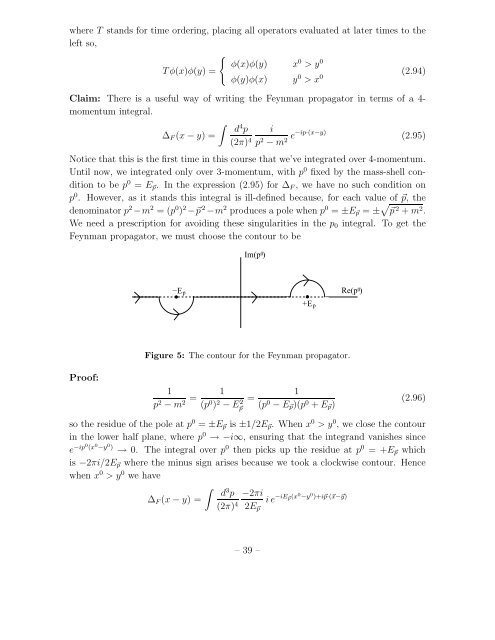Quantum Field Theory
Quantum Field Theory
Quantum Field Theory
You also want an ePaper? Increase the reach of your titles
YUMPU automatically turns print PDFs into web optimized ePapers that Google loves.
where T stands for time ordering, placing all operators evaluated at later times to theleft so,{φ(x)φ(y) x 0 > y 0Tφ(x)φ(y) =(2.94)φ(y)φ(x) y 0 > x 0Claim: There is a useful way of writing the Feynman propagator in terms of a 4-momentum integral.∫d 4 p i∆ F (x − y) =e−ip·(x−y) (2.95)(2π) 4 p 2 − m 2Notice that this is the first time in this course that we’ve integrated over 4-momentum.Until now, we integrated only over 3-momentum, with p 0 fixed by the mass-shell conditionto be p 0 = E ⃗p . In the expression (2.95) for ∆ F , we have no such condition onp 0 . However, as it stands this integral is ill-defined because, for each value of ⃗p, thedenominator p 2 −m 2 = (p 0 ) 2 −⃗p 2 −m 2 produces a pole when p 0 = ±E ⃗p = ± √ ⃗p 2 + m 2 .We need a prescription for avoiding these singularities in the p 0 integral. To get theFeynman propagator, we must choose the contour to beIm(p 0)−E p+ E pRe(p 0)Proof:Figure 5: The contour for the Feynman propagator.1p 2 − m = 12 (p 0 ) 2 − E⃗p2=1(p 0 − E ⃗p )(p 0 + E ⃗p )(2.96)so the residue of the pole at p 0 = ±E ⃗p is ±1/2E ⃗p . When x 0 > y 0 , we close the contourin the lower half plane, where p 0 → −i∞, ensuring that the integrand vanishes sincee −ip0 (x 0 −y 0) → 0. The integral over p 0 then picks up the residue at p 0 = +E ⃗p whichis −2πi/2E ⃗p where the minus sign arises because we took a clockwise contour. Hencewhen x 0 > y 0 we have∫∆ F (x − y) =d 3 p(2π) 4 −2πi2E ⃗pi e −iE ⃗p(x 0 −y 0 )+i⃗p·(⃗x−⃗y)– 39 –
















